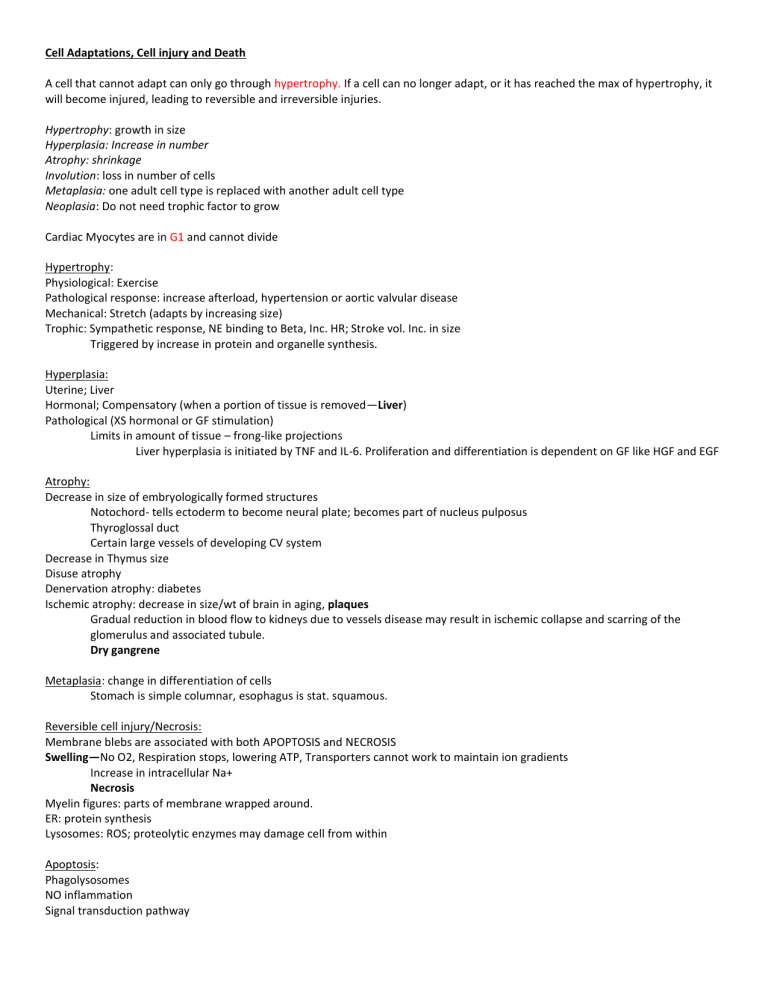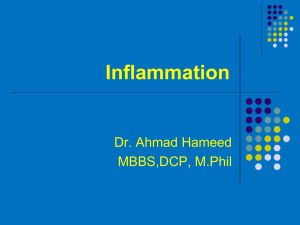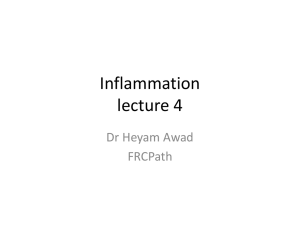Pathology0
advertisement

Cell Adaptations, Cell injury and Death A cell that cannot adapt can only go through hypertrophy. If a cell can no longer adapt, or it has reached the max of hypertrophy, it will become injured, leading to reversible and irreversible injuries. Hypertrophy: growth in size Hyperplasia: Increase in number Atrophy: shrinkage Involution: loss in number of cells Metaplasia: one adult cell type is replaced with another adult cell type Neoplasia: Do not need trophic factor to grow Cardiac Myocytes are in G1 and cannot divide Hypertrophy: Physiological: Exercise Pathological response: increase afterload, hypertension or aortic valvular disease Mechanical: Stretch (adapts by increasing size) Trophic: Sympathetic response, NE binding to Beta, Inc. HR; Stroke vol. Inc. in size Triggered by increase in protein and organelle synthesis. Hyperplasia: Uterine; Liver Hormonal; Compensatory (when a portion of tissue is removed—Liver) Pathological (XS hormonal or GF stimulation) Limits in amount of tissue – frong-like projections Liver hyperplasia is initiated by TNF and IL-6. Proliferation and differentiation is dependent on GF like HGF and EGF Atrophy: Decrease in size of embryologically formed structures Notochord- tells ectoderm to become neural plate; becomes part of nucleus pulposus Thyroglossal duct Certain large vessels of developing CV system Decrease in Thymus size Disuse atrophy Denervation atrophy: diabetes Ischemic atrophy: decrease in size/wt of brain in aging, plaques Gradual reduction in blood flow to kidneys due to vessels disease may result in ischemic collapse and scarring of the glomerulus and associated tubule. Dry gangrene Metaplasia: change in differentiation of cells Stomach is simple columnar, esophagus is stat. squamous. Reversible cell injury/Necrosis: Membrane blebs are associated with both APOPTOSIS and NECROSIS Swelling—No O2, Respiration stops, lowering ATP, Transporters cannot work to maintain ion gradients Increase in intracellular Na+ Necrosis Myelin figures: parts of membrane wrapped around. ER: protein synthesis Lysosomes: ROS; proteolytic enzymes may damage cell from within Apoptosis: Phagolysosomes NO inflammation Signal transduction pathway Cellular function may be lost before cell death occurs; will be lost even in reversible injury Irreversible injury, typically associated with mitochondrial dysfunction; profound disturbances in membrane function -> Cell death ETC final acceptor is O2 but e- may turn into ROS causing damage to lipids, proteins, DNA Reversible injury: -Cellular swelling -Fatty change esp in liver; myocardial cells -Ultrastructural changes Membrane blebs Amorphous densities Dilation of ER causing detachment of ribosomes Clumping of nuclear chromatin—apoptosis Necrosis: Intracytoplasmic contents of necrotic cells may leak out Troponin from muscle cells (cardiac specific forms) Aspartate and Alanine transaminases from the liver Morphological features: Inc. eosinophilia (acidic) Myeline figues—derived from cell membranes Calcification Loss of nuclei Karyolysis: Lysing of nucleus Pyknosis: condensation of nucleus Karyorrhexis: fragmentation of nucleus Coagulative necrosis: Loss of blood flow= loss of lysosomal enzyme function—cannot degrade area leading to gelatinous state. Hemmorhagic necrosis: A secondary artery will fill in necrotic area Dry gangrene: Requires amputation Liquefactive necrosis: Implies that it occurs in the CNS (form of coagulative) When neutrophils build up, release “pus” Casseous necrosis: Associated with TB; cheese-like white, crumbly May cause systemic infection Fat necrosis: Necrosis of pancreatic cells, which contain large amounts of hydrolytic enzymes.. digest Triglycerides to form FA. FA will combine with Ca2+ to form soaps (saponification) Fibrinoid necrosis: Extreme hypertension or immune complex – leakage of fibrin and plasma proteins into vessel wall Calcium is usually in the sarcoplasmic reticulum or outside a cell. Calcium will begin to rush into Cytoplasm activating second messenger cascade. ROS and Fe+ may cause Fentin RXN making Hydroxyl radicals attacking membranes creating lipidPeroxide (damaged membrane) Decrease of ATP will decrease function of Na+ pumps, increase anaerobic glycolysis and detach Ribosomes Damage to mitochondrial permeability transition pore -leads to the loss of mitochondrial membrane potential and pH changes causing H+ to leak out of the membrane into INNER membrane (ETC) -failure of oxidative phosphorylation with decrease ATP There is also leakage of cytochrome c and other pro-apoptotic proteins into cytoplasm Sites of membrane damage: -mitochondrial -plasma membrane -injury to lysosomal membranes Reperfusion injury: Metabolites enter the area Cells in the area become accustomed to hypoxia; when O2 rushes into the area, the O2 is used to turn into ROS.. in turn, the ROS will attack everything else Chemical (toxic) injury: Some chemicals may become toxic through cellular processes involving P450. Metabolism creates free radicals -triglycerides accumulate in the liver causing fatty liver disease; if concentration of toxin is very high—necrosis APOPTOSIS: Activated by a cascade of enzymes that lead to degredation of DNA, nuclear and cytoplasmic proteins Fragmentation of cells turn into apoptotic bodies which are phagocytosed. Apoptosis of T-lymphocytes that are self-reactive as to not cause rheumatoid illness Triggering by internal signals – the intrinsic or mitochondrial pathway Triggering by external signals – the extrinsic or death receptor pathway -FAS-FAS Caspases: Cysteine proteases Initiator: 2,8,9 Executioner: 3, 6, 7 Caspase activated DNAse results in DNA cleavage between nucleosomes (150-180bp) BCL-2 is PROSURVIVAL and found in the outer membrane of the cell Bax/Bak (proteins) are pro-apoptotic, and if there is a misfunction, there may be neoplasia When bound, cytochrome C is released (first step in apoptosis) P53 will upregulate Bax Intrinsic pathway Due to: cell/mitochondrial damage or hormone withdrawal Results in BCL-2 release of Apaf-1 (apoptotic protease activating factor) into the cytoplasm Apaf-1 allows the escape of cytochrome c form mitochondria Apaf-1, cytochrome c, and procaspase 9 (initiator) polymerize into apoptosome Caspase 9 is activated and that cleaves and activates other caspases in the apoptotic cascade Fas/Fas Ligand Trimerized death domain that interacts with other intracellular death domains such as FADD which leads to the activation of Caspase 8 (initiator) which will activate initiator caspases and eventually apoptosis Accumulation of protein Protein resorption droplets in the renal tubular epithelial cells A glomerular defect allows the protein to spill into the bowman’s space; the tubules try to resorb the protein but it cannot be metabolized and exported quickly enough Accumulation of metals Small amounts of iron undergo autophagy, resulting in Hemosiderin (a brown pigment) There is no physiological route for iron excretion so excess intracellular iron will cause injury due to free-radical formation and lipid peroxidation resulting in DNA damage as well as collagen synthesis resulting in fibrosis Inflammation and Repair DOLOR: Bradykinin (potentiates prostaglandins), substance P cause pain TUMOR: swelling CALOR: heat from increases blood flow RUBOR: redness from inflammatory agents increasing blood flow Vasocontraction: Endothelin is released and binds to vascular SM (Gq receptor associated with DAG, IP3, Ca2+, contraction) on ET1, ET2 Increases CA2+ and contraction Vasodilation: more blood flow increasing inflammatory markers, increase in vascular permeability, increasing protein increasing viscosity, decreasing velocity PAMPS: Pathogen associated molecular pattern are recognized by toll-like receptors Toll-like receptors will activate the transcription and production of inflammatory mediators and cytokines Inflammasome: group of proteins that come together to instill an Inflammatory reaction by binding to caspase-1 and pro-inflammatory 1Beta leading to acute inflammation Stasis will increase chances of WBC to begin rolling and binding TRANSCUDATE: Due to decrease in colloid osmotic pressure, only loss of fluid, not protein EXCUDATE: Due to inflammation, increase to vascular permeability, fluid and protein leakage (edema) Pericyte: responsible for contraction of capillaries Endothelial contraction: Venules Histamine, bradykinin, leukotrienes Immediate transient response If this is not controlled, junctional retraction occurs Junctional retraction: Caused by increased cytokines (IL-1, TNF) with onset of 4-6 hours Leukocyte-dependent injury: free radicals and protease released from leukocytes injure endothelial cells Increased transcytosis: vascular endothelium derived GF (VEGF) New blood vessel formation: tight junctions are not present yet and so there is increased vascular permeability Selectins: cytokine activated (TNF, IL-1) from macrophage. Selectins will appear on endothelium, bind to sialyated groups on antigens on leukocytes Immunoglobulin-like: on endothelial and will bind to the integrin on the leukocyte PECAM-1: allow the cell to slip through the endothelium Integrins: bind to the immunoglobulin like ligands on the endothelial cells. Transform into high affinity state after chemokine (proteoglycan) activation of leukocytes Leukotriene B4 is a major chemotaxis substance, product of COX Within neutrophil: Myeloperoxidase and Chloride and take hydrogen peroxide and make a OCL* free radical lipid peroxide which will lyse bacteria within the phagocyte Types of Inflammation: Serous: very mild inflammation due to increased plasma protein due to increased vascular permeability Suppurative (Purulent) Inflammation and Abscess formation Mediators of inflammation: Cell derived: Granules: mast cells, basophils, platelets have histamine Histamine binds to H1 receptors causing constriction of large arteries but dilation of arterioles as well an increased venular permeability via endothelial cell contraction Serotonin is found in dense granules in platelets causing aggregation and coagulation Plasma derived: Liver makes acute phase coagulating factors Complement Kinin- factor 12 Platelet activating factor increases aggregation of platelets by bringing them Main pyrogen: TNF works on hypothalamus increasing basal body temperature Acute phase protein: CRP, coagulative factors, complements • Synthesized by the liver, these proteins are secreted in response to stimulation by circulating IL-6 – C-reactive protein - opsonin – Fibrinogen – Serum AA protein – opsonin Chemokines: Expressed, and presumably Secreted: – eotaxin – platelet factor 4 – monocyte chemoattractant protein-1 (MCP-1) – RANTES: “Regulated upon Activation, Normal T-cell IL-8 – polypeptide chemokine produced by activated macrophages – potent chemoattractant and activator of neutrophils Oxygen Derived Free Radicals: from neutrophils and macrophages Free radicals have the potential of damaging endothelial cells. They will also creat chemotactic lipids, inactivate A1AT, produced by the NADPH oxidative reaction in leukocytes. Alpha-1-antitrypsin deficiency: buildup of abnormally folded A1AT and can cause liver damage, inactivates WBC enzymes Genetic disorder Abscense of the protein systemically results in lung damage since there is no inactivation of WBC iNOS: opposing to eNOS; found in macrophages and monocytes, activated by TNF and IL-1. Microbiocidal and works with ROS • C3a and C5a are anaphylatoxins, causing histamine release and thus ↑ vascular permeability and vasodilation • C3b and C3bi are opsonins • C5b-C9 form the membrane attack complex and cause lysis of bacteria and cells • C5a is also associated with: – leukocyte activation – adhesion – chemotaxis Plasma proteinases: Kinin system Activated by Factor 12 (Hageman) to convert prekallikrein to kallikrein, then HMWK to Bradykinin Bradykinin will increase vascular permeability, induce SM contraction, arteriolar dilation, and most importantly PAIN When fibrin is formed, fibrinopeptides are split which also increase vascular permeability and act as chemotactic for leukocytes Plasmin converts C3 to C3a (inflammation reaction) Chronic inflammation characteristics: often caused by persistent infections and the body’s inability to kill; persistent autoimmune response Angiogenesis Tissue destruction and fibrosis formation Infiltration of monocytes Macrophage activation Classical Activation Activated by interferon gamma from T-cells Produce lysosomal enzymes, NO, and ROS to kill bacteria Secrete inflammation inducing cytokines (TNF, IL-1) Host defense Alternative activation Associated with lymphocyte IL-4 and IL-13 Involved in tissue repair Promote angiogenesis, fibroblasts, collagen formation, and antinflammation through TGF-Beta Acute Phase Reaction: Systemic effects associated with inflammation IL-1, IL-6, TNF (which are produced by leukocytes in response to bacterial LPS) Pyrogens may be endogenous/exogenous (bacterial LPS—stimulate IL-1/TNF) These increase COX in hypothalamus which increases prostaglandins Leukocytosis: associated with bacterial infections when TNF and IL-1 release cells from bone marrow (prolonged release is dependent on colony stimulating factor) Because cells are being released so rapidly, there may be an increased ratio of immature granulocytes. Tissue repair Regeneration is possible with an intact basement membrane; once it is destroyed by severe injury, it causes a more vigorous inflammatory response causing increased accumulation of fibroblasts and collagen resulting in a scar. Cell proliferation is controlled via growth factors; dependent on cell type There are two SNA damage check points in the cell cycle @ G1/S and G2/M Stem Cells -self-renewal: allows maintenance of functional population of precursors - asymmetric replication: stem cell divides, one daughter enters a differentiation pathway while the other remains undifferentiated Cells may be cultured by adding certain growth factors such as c-Myc (which when mutated in cancer cells results in a loss of proliferation control) Growth factors: proteins that stimulate the survival and proliferation of particular cells. They promote migration, differentiation and other cellular responses. They typically bind to tyrosine-kinase receptors GPCRs are important for binding chemokines and mediating chemotaxis of WBC JAK/STAT receptors can have signalling molecules bind directly to DNA Extracellular matrix: network of protein that sequester H2O and supplies turgor to tissue, gives rigidity to bone, supplies a substrate for cell migration and adhesion, as well as a reservoir for growth factors. Interstitial matrix found between cells in connective tissue, and between epithelium and supportive vascular and smooth muscle structures; made mostly of mesenchymal fibroblast fibrillar/non-fibrillar collagen fibronectin; elastin proteoglycans hyaluronate Basement Membrane Forms plate-like mesh between epithelium and mesenchyme Nonfibrillar type iv collagen Laminin I (Integrins on epithelial cells bind to laminin on BM) Proteoglycans Collagens and elastins: Fibrous structural proteins which confer tensile strength and recoil Collagen: 3 polypeptide chains in triple helix Fibrillar: 1, 2, 3, 5 cross-link laterally due to lysyl-oxidase, Vit C requiring enzyme Found in scar tissue Nonfibrillar: 4 found in BM Elastin: Gives ability to recoil and return to baseline structure Large blood vessels, uterus, skin, ligaments Proteoglycans and Hyaluronan: Water-hydrated gels which permit resilience and lubrication Proteoglycans: highly hydrated gel-like compressible for joints Serves as a reservoir for growth factors Made up of long protein backbone with glycoaminoglycans like heparan sulfate Hyaluronan: large mucopolysaccharide without a protein core that forms a viscous gel-like matrix Laminin, fibronectin, integrins: Adhesive glycoproteins that connect matrix elements to one another and to cells Laminin: most abundant in BM, connects cells to underlying ECM components such as type 4 collagen and heparan sulfate; helps modulate cell proliferation Fibronectin: disulfide linked heterodimer binds to large number of ECM components including collagen and proteoglycans, binds fibrin Integrins: transmembrane heterodimeric glycoprotein chains, important for leukocyte adherence to endothelium, main receptor for laminins and fibronectin. Seen in membrane of all cells except for RBC Steps in Angiogenesis • Vasodilation in response to NO and increased vascular permeable in response to VEGF • Separation of pericytes from the outside • Migration of endothelial cells toward the area of tissue injury • Proliferation of endothelial cells just behind the leading front of migrating cells • Remodeling into capillary tubes • Recruitment of peri-endothelial cells to form mature blood vessel (Ang) • Suppression of endothelial proliferation and migration, and deposition of basement membrane Growth factors involved in angiogenesis: VEGF (VEGF-A), Ang1, Ang2 which stabilize blood vessels, and FGF VEGF Major inducer of angiogenesis following injury, expressed in most tissues (especially in the epithelium) Binds to tyrosine-kinase receptors Induced by hypoxia, TGF-beta, TBF-alpha, PDGF Stimulates proliferation and migration of endothelial cells, initiating sprouting of capillaries from existing vessels Fibroblast Growth Factors (FGF) Bind to tyrosine kinase receptors, heparan sulfate on proteoglycan of CT Stimulates proliferation of endothelial cells Migration of macrophages and fibroblasts to injured area Angiopoetins 1 & 2 Ang1, Ang2 Stabilization of new vessels Recruitment of new pericytes, smooth muscle and surrounding ECM Transforming growth factor Beta Binds to serine-therosine kinase Anti-inflammatory Stimulates production of collagen, fibronectin, and proteoglycans, and inhibits collagen degradation by decreasing MMPs and increasing the activity of tissue inhibitors of metalloproteinases (TIMPS) TGF- b suppresses endothelial proliferation and migration, and enhances the production of ECM proteins Platelet derived growth factor (PDGF) Proliferation and migration of smooth muscle and fibroblasts Matrix metalloproteinases (MMPs) Zinc containing enzymes that can cleave a Large number of different ECM components, including fibrillar and nonfibrillar collagen, fibronectin, proteoglycans, and laminin. Produced by wide variety of cells, especially fibroblasts, macrophages and neutrophils, but under regulation of growth factors and cytokines Action opposed by TIMPs produced by most mesenchymal cells.

